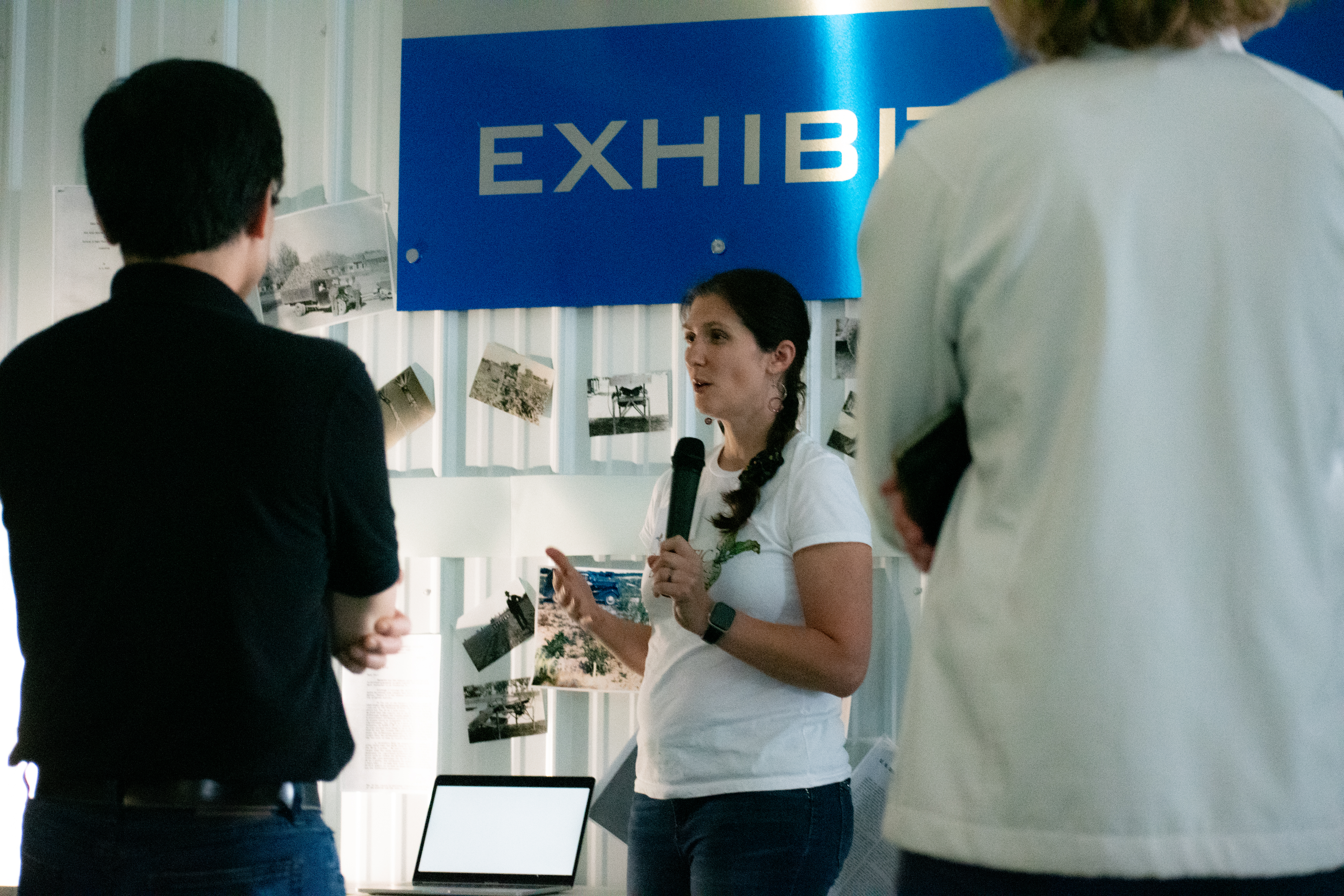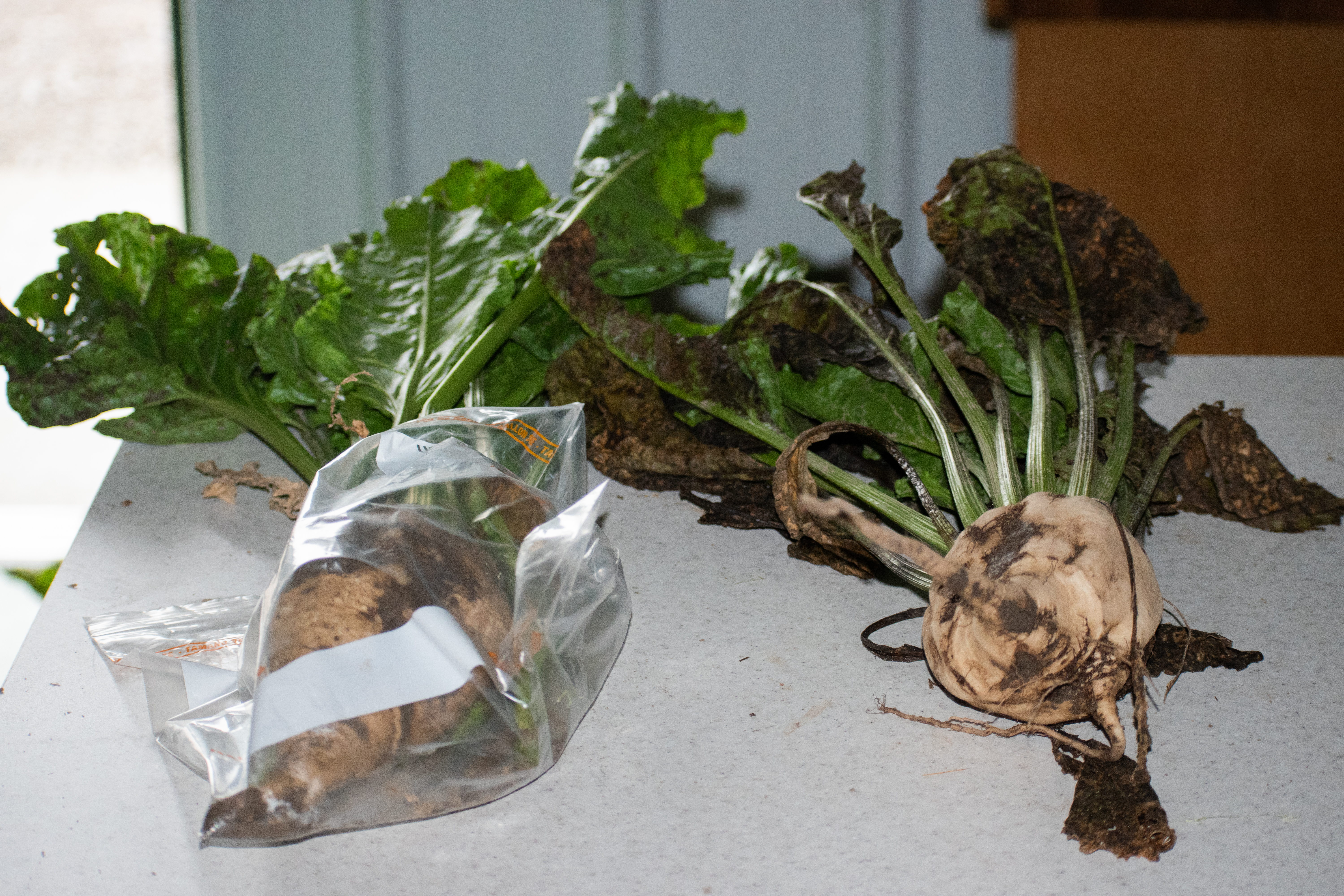100 years of MSU-USDA sugar beet research celebrated
Monumental milestones pave the way for industry advancements
FRANKENMUTH, Mich. — Michigan State University and the U.S. Department of Agriculture’s (USDA) Agricultural Research Services (ARS) are celebrating 100 years of research collaboration in advancing sugar beet production in Michigan and beyond.
Rachel Naegele, USDA-ARS research geneticist and adjunct assistant professor in the MSU Department of Plant, Soil and Microbial Sciences, said genomic advancements in particular have sped up the industry’s ability to meet consumer demand.
In 1923, the USDA Bureau of Plant Investigations moved sugar beet research in Michigan from Blissfield to East Lansing, according to historical records and a report by Mitch McGrath, former USDA-ARS sugar beet breeder and adjunct professor in the MSU Department of Plant, Soil and Microbial Sciences. This geographical shift established a cooperative agreement for USDA to work with and have a direct path to Michigan Agricultural College, now Michigan State University.

Naegele said McGrath’s research from 1996 to 2019, as well as the work of other scientists before and after, have forged and implemented research practices to advance the identification of traits sought after by both public and private sectors.
“It’s just this continuous two-way communication,” Naegele said. “USDA-ARS scientists and MSU scientists communicate with the (sugar beet) industry. The industry tells them what’s important or what it’s seeing. There’s real connectivity and comfortableness to be able to do that. And because of that, we scientists can identify problems early, spread the word and get information out to different people.”
In 2022, Michigan farmers harvested 3.97 million tons of sugar beets across 138,000 acres — averaging 28.8 tons per acre — according to the USDA National Agriculture Statistics Service. The Michigan Sugar Company uses the beets to annually produce about 1.2 billion pounds of sugar, generating approximately $600 million, according to its website.
The MSU-ARS collaborations were highlighted and commemorated during the Aug. 23 field day at the MSU AgBioResearch Saginaw Valley Research and Extension Center (SVREC).

The centennial celebration, which capped off the sugar beet and dry bean field day hosted by MSU AgBioResearch and MSU Extension, included an overview of MSU and USDA-ARS’s sugar beet accomplishments and current research, as well as a historical synopsis of sugar beet breeding. The office of U.S. Congressman Dan Kildee (Flint, Michigan) also presented a congressional declaration recognizing the collaboration’s anniversary.
Linda Hanson, USDA-ARS research plant pathologist and adjunct professor in the MSU Department of Plant, Soil and Microbial Sciences, moderated the celebration.
Those remarking on the centennial celebration included:
- Rosalind James, director of USDA-ARS Midwest Area.
- James Kells, former assistant director of MSU AgBioResearch and professor emeritus in the MSU Department of Plant, Soil and Microbial Sciences.
- Nora Lapitan, deputy administrator for crop production and protection at USDA-ARS.
- Renfu Lu, USDA-ARS research unit leader at MSU and an adjunct professor in the MSU Department of Biosystems and Agricultural Engineering.
- Anna Murphy, executive vice president of the Beet Sugar Development Foundation (BSDF) and American Society of Sugar Beet Technologists (ASSBT).
- Rachel Naegele, USDA-ARS research geneticist and adjunct assistant professor in the MSU Department of Plant, Soil and Microbial Sciences.
- Paul Pfenninger, former executive vice president of BSDF, ASSBT and Michigan Sugar Company.
- Wei Zhang, associate chair and professor in the MSU Department of Plant, Soil and Microbial Sciences.
“The ARS scientists are employees of the USDA, but they’re also adjunct faculty members in an academic unit of MSU’s College of Agriculture and Natural Resources,” Kells said. “They have their own research priorities, but they also collaborate with MSU faculty.
“They’re valuable members of their departments.”
In addition to the centennial celebration, the field day highlighted key research performed on sugar beets and dry beans. The agronomy, production and variety advancement of sugar beets and dry beans were discussed, as well as disease and weed concerns.
Field day presenters included:
- Scott Bales, dry bean systems specialist in the MSU Department of Plant, Soil and Microbial Sciences.
- Christina DiFonzo, professor in the MSU Department of Entomology.
- Corey Guza, director of research and agronomy at Michigan Sugar Company.
- Linda Hanson, USDA-ARS research plant pathologist and adjunct professor in the MSU Department of Plant, Soil and Microbial Sciences.
- Christy Sprague, professor in the MSU Department of Plant, Soil and Microbial Sciences.
- Kurt Steinke, associate professor in the MSU Department of Plant, Soil and Microbial Sciences.
- Jaime Willbur, assistant professor in the MSU Department of Plant, Soil and Microbial Sciences.
The Michigan Bean Commission and Michigan Sugar Company also helped facilitate the event and conversation amongst industry partners and researchers.
History and current state of MSU, USDA-ARS sugar beet partnership
As sugar beet breeders, geneticists and pathologists continued to join the East Lansing program after 1923, the capacity to conduct sugar beet breeding research grew.
During the 1930s and 1940s, breeders attempted to find the monogerm trait that gave rise to a single sugar beet plant from a single seed with one embryo. This was unlike other sugar beet seeds during the time that had multiple embryos and spawned multiple plants (from one seed). In 1948, beets that produced monogerm seeds were discovered from a Michigan-developed hybrid called MI-18, revolutionizing the industry.
The program’s continued research advancements have helped produce different beet varieties, like the ‘US-H20’ in 1968, which became an important variety for Great Lakes region farmers for more than a decade.
An expanded ability to study disease resistance, as well as breeding, helped drive the foundation behind MSU’s joint relationship with USDA-ARS. Diseases like Aphanomyces root rot, which can damage the root of sugar beet plants and in some cases, cause the plant to die, have been constrained and addressed with effective disease resistance breeding.
Diseases like Cercospora leaf spot, though, can still plague sugar beets. Historically a nuisance for sugar beet farmers, Cercospora leaf spot creates small lesions that damage the surface of the plant and interfere with photosynthesis, decreasing the beet’s sugar content. Hanson said roughly $10 million is annually invested in Michigan’s sugar beet industry to manage the disease. It’s an amount the industry wants to eventually reduce.

Disease resistance and early emergence work by MSU and USDA-ARS scientists, however, has helped minimize Michigan sugar beet yield losses by 15%, said Hanson.
Current efforts — mostly overseen at SVREC in Frankenmuth, where the bulk of Michigan’s sugar beet production occurs — are being directed to further track, understand and react to diseases changes and environmental stressors, such as how drought and salt impact growth response.
“Beet seedlings are very wimpy, so we’re trying to make them a little less wimpy,” Hanson said.
Agriculture leaders in attendance said the contribution MSU and USDA-ARS scientists continue to make not only impact Michigan’s sugar beet industry, but the industry countrywide. Some of the benefits detailed included having Naegele and Hanson’s knowledge on breeding and disease readily available to industry experts, as well as Sprague’s knowledge on weed control — acknowledging her presentation during the field day on managing waterhemp, an herbicide-resistant weed affecting sugar beets and other crops.
Additional agricultural, engineering industries benefit from collaboration
The MSU-based USDA-ARS research unit efforts extend beyond scientific exploration of sugar beets.
The unit — part of the larger USDA-ARS Midwest Area — has three programs focused on sugar beets, dry beans and engineering. Four on-campus greenhouses owned by the USDA support the unit’s sugar beet and dry bean research.
Lu said his expertise is directed toward developing technology for harvesting and inspecting fruits and vegetables. He and other engineers have worked to design innovative and autonomous prototypes that harvest and sort apples – a process that could have sugar beet implications.
He also said scientists in his unit are studying ways to produce dry beans that have improved nutritional and end-use traits, specifically ones involving faster cooking rates.
Looking toward the future, Lu said he sees opportunities for MSU and USDA-ARS to grow their long-standing relationship.
“We will probably need to work even closer to address climate change related issues,” Lu said.
Michigan State University AgBioResearch scientists discover dynamic solutions for food systems and the environment. More than 300 MSU faculty provide expertise from health, packaging, forestry, and fisheries and wildlife to supply chain management, climate, water, economics and entomology. Originally formed in 1888 as the Michigan Agricultural Experiment Station, MSU AgBioResearch oversees numerous on-campus research facilities, as well as 15 outlying centers throughout Michigan’s Lower and Upper Peninsulas. Research meets industry needs with outcomes that support Michigan food producers, natural resource stewards, residents and consumers. To learn more, visit agbioresearch.msu.edu.



 Print
Print Email
Email





